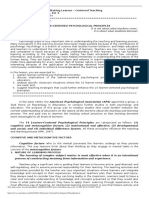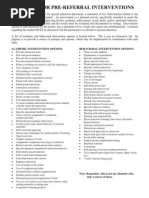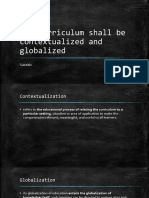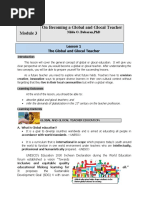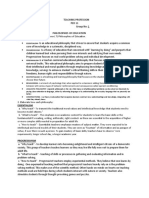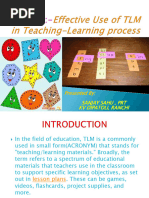Continuing Professional Development: The Lifeblood of Teaching Profession
Continuing Professional Development: The Lifeblood of Teaching Profession
Uploaded by
Jessa Verzosa TadiwanCopyright:
Available Formats
Continuing Professional Development: The Lifeblood of Teaching Profession
Continuing Professional Development: The Lifeblood of Teaching Profession
Uploaded by
Jessa Verzosa TadiwanOriginal Description:
Original Title
Copyright
Available Formats
Share this document
Did you find this document useful?
Is this content inappropriate?
Copyright:
Available Formats
Continuing Professional Development: The Lifeblood of Teaching Profession
Continuing Professional Development: The Lifeblood of Teaching Profession
Uploaded by
Jessa Verzosa TadiwanCopyright:
Available Formats
Continuing Professional Development: The Lifeblood of
Module 7 Teaching Profession
-Edgardo Sario
Introduction
This module is devoted to discussion of Continuing Professional Development.
It traces the history of CPD for professional teachers in the Philippines and also
discusses its philosophical basis with the aim of instilling in teachers the genuine
desire for CPD.
The professional license for teaching obtained after passing the Licensure
Examination for Teachers (LET) simply tells that the professional teachers possesses
the minimum competencies expected to continue developing after obtaining his/ her
professional license. This is one big demand for professional teacher. The Code of
professional Conduct for Public School Teachers cited in Section 7 of RA 4670 states
“Responsibility is something expected of a professional teacher. The work of the
teacher in the development and guidance of the young is a tremendous responsibility
for which he is accountable to God, to his Country, and to prosperity. It is a trust of
which every teacher should strive to be worthy.”
In fact, all professional teachers owe it to themselves and to the clientele they
serve to go through CPD. When doctors and nurses commit mistake, they bury their
mistake. When lawyer commits Mistake, he/ she put her mistake behind bars. What
about the teacher? When a teacher commit a mistake. A professional needs to go
through CPD.
The Philippine Professional Standard for Teachers (the revised Nation
Competency-Based Teacher Standards) includes personal growth and professional
development as the seventh domain. With the enactment of RA 10912, the CPD Law
of 2016, CPD for all the professions regulated by PRC is now mandatory, Mandating
CPD is the only way all professionals including teachers are made to go through CPD.
CPD for professional development for professional teachers sharpens the professional
teachers competitive edge in highly competitive global world.
Learning Outcome
A. Discuss why Continuing Professional Development (CPD) is essential for
Professional Teachers;
B. Cite the relevant provisions of the CPD Act of 2016, and
C. Explain authentic desire for Continuing Professional Development
Learning Content
The Philosophical Basis of CPD
“Growth is an evidence of Life.” This implies that anything that is alive grows or
anything that grows is alive. So a teacher who is alive grows physically,
The Teaching Profession Module – Isabela State University Page 137
psychologically, mentally, socially, emotionally, spiritually. If he/ she don’t grow, it
means he/she is no longer alive.
“Man/ woman is an unfinished project.” For a professional teacher, he/she is
always in the process of becoming better and better as a person and as a professional
teacher. No person, no professional can claim he/she has already “arrived” at a state
of perfection. Neither “perfecta” nor “perfecto” who is perfect by name is not perfect.
This means that no professional has arrived at perfect state. This implies that every
professional is expected to continue developing.
The Historical and Legal Bases of Continuing Professional Development in the
Philippines
Even before the enactment of this CPD Act of 2016, CPD was already alluded
to in the 1987 Philippine Constitution. No less than the Fundamental law of the land,
Section 5, Paragraph 4, states: “The States shall enhance the right of teachers to
professional advancement.
Other laws also cited continuing professional development, as follows:
1. Batas Pambansa 232, the education Act 1982, chapter 3. Duties and
Obligations, Section 16, (4) states as one of teacher’s obligation to assume the
responsibility to maintain and sustain his professional growth and
advancement…”
2. RA 9155, an act instituting a framework of Government for Basic Education,
Establishing Authority and Accountability, renaming the Department of
Education, Culture and Sports as the Department of Education, and for other
purposes, was enacted on August 11, 2001. In the enumeration of duties and
functions of the Secretary of Education, Section 7A., to with.
In addition to his/her powers under existing laws, the Secretary of
Education shall have authority, accountability and responsibility among
other things for …(6) enhancing the employment status, Professional
Competence, welfare and working conditions of all personnel of the
Department;… Section 7, E states, to wit.”… Consistent with the nation
educational policies, plans and standards, the school heads shall have
authority, accountability and responsibility for… encouraging staff
development.” (Underscoring mine)
3. RA 7836, the teacher’s professionalization Act, also provided for mandatory
Continuing Professional Education (CPE), now referred to as Continuing
Professional Development (CPD), to wit:
To encourage continuing professional growth and development and to
provide additional basis for merit promotion, in addition to their
performance rating, teachers may take an oral and written examination
at least once in five (5) years as basis for merit promotion. In taking
The Teaching Profession Module – Isabela State University Page 138
this examination, no fee shall be required (Sec. 19 Periodic Merit
Examination of Teachers).
Unfortunately, due to lack of funding, the merit examination has not been
implemented up to writing time.
4. The Board For Professional Teachers (BPT) also passed Resolution No. 435, S.
177 to adopt the Code of Ethics for Professional Teachers pursuant to the
provisions of paragraph (e) Article 11 of RA. 7836, otherwise known as The
Philippine Teacher’s Professionalization Act of 1994. This Code of Ethics
states:
Every teacher shall participate in the Continuing Professional Education
(CPE) program of the Professional regulation Commission, and shall
pursue such other studies as will improve efficiency, enhance the
prestige of his profession, and strengthen his competence, virtues, and
productivity in order to be nationally and internationally competitive.
(Section 3, Article IV).
5. Executive Order # 266, Institutionalization of the Continuing Professional
Education (CPE) Programs of the Various Professional Regulatory Boards
(PRBs) Under the Supervision of the Professional Regulation Commission
(PRC). This was signed and issued by the Office of then President Fidel V.
Ramos on July 25, 1995, to wit:
The completion by professional licenses of the Continuing Professional
Education (CPE) programs adopted by all boards is hereby imposed as
a mandatory requirement for the renewal of professional licenses
(Sec.1)
The Executive Order was premised on the following:
WHEREAS, it is imperative to impose upon registered professionals the
completion of the continuing Professional Education (CPE) programs adopted
by the concerned board as pre-requisite for the renewal of their licenses:
WHEREAS, the professionals who undertake the CPE programs are
enabled not only to upgrade or improve their technical knowledge and skills
but also to keep them abreast with modern trends and technology in their
respective professions, thereby assuring the rendition of highly qualitative
professional service/s that will be globally competitive under the General
Agreement on Trade in Services (GATS) and the same time securing the safety
and protection of the Public;
WHEREAS, the confidence and patronage of the public in a professional
depend upon his competence and the quality of service rendered resulting
from his acquisition of updated technical knowledge and skill;
6. R.A. 10912, Continuing Professional Development Act of 2016- with enactment
of this law, CPD for all the forty three (43) professions regulated by PRC
including the Teaching profession has become mandatory.
The Teaching Profession Module – Isabela State University Page 139
The Salient Provisions of RA 10912, The Continuing Professional Development Act of
2016
A lot of questions have been raised RA. 10912, otherwise known as the
Continuing Professional Development Act of 2016. Many a teacher resists CPD. It is
claimed to be extra effort and extra time when in fact it is very professional’s
obligation. CPD is the only way Professionals can sharpen their competitive edge in an
international world that has become global village. The need for CPD is heightened by
ASEAN integration and internalization which are now real. To be in, a professional
must meet international standards. The way to go is CPD.
The purposes of CPD for professional are stated in RA 10912 Article 1
Declaration of Policy.
It is hereby declared the policy of the State to promote and upgrade the
practice of professions in the country. Towards this end, the state shall institute
measures that will continuously improve the competence of the professionals in
accordance with the international standards of practice, thereby, ensuring their
contribution in uplifting the general welfare, economic growth and development of the
nation, (Underscoring mine)
The State policy on promoting and upgrading the practice of professions in the
country and the institution of measures to “continuously improve the competence of
the professionals in accordance with international standards” and gives Filipino
professional a competitive edge in the ASEAN region and in the world.
Number of CPD Units Required
Article III, Section 10 of the same CPD Act states: “the CPD is… made as a
mandatory requirement in the renewal of the Professional Identification Card (PICs) of
all registered and licensed professionals… How many credit units are required for the
renewal of PICs? For the professional teachers’ group, based on Professional
Regulatory Board for Professional teachers Resolution No. 11, series of 2017, the
following credit units are required:
Period No. of Credit Units Required
December 2017 15 Credit units
January- December 2018 30 Credit units
January 2019 onwards 45 Credit units
Ways by which Professional Teachers can Earn Credit Units
As shown in the figure below CPD credit units can be earned in 4 ways.
1. Professional Tack- This includes trainings provided by CPD providers accredited
by PRC. You can earn credit units as a participant to a training approved by the
CPD Council. You earn more credit units if you serve as a resource speaker,
trainer or demonstration teacher. You also earn credit units as panelist/
The Teaching Profession Module – Isabela State University Page 140
reactor, facilitator, moderator. You earn much more if you are assigned by the
CPD Council to monitor the conduct of an approved CPD Program.
2. Academic Track- this refers to the completion of a Master’s degree, completion
of candidacy to the doctorate program, completion of a post-doctoral diploma,
and being a recipient of a professorial chair grant, and/or fellowship grant.
Take note that ONLY COMPLETION of the Master’s degree is given full credit
units of 45. Earning MA units is not given any credit unit but completion of
candidacy for the Doctorate Degree already entitles one to 45 units. The
Master’s and doctorate degrees must have been earned five (5) years before
renewal of Professional License.
3. Self-directed-track- this includes trainings offered by non-accredited CPD
Providers. It refers to “learning activities such as online training, local/
international seminars/ non-degree courses, institution/ company- sponsored
training programs and the like which did no undergo CPD accreditation but
may be applied for and awarded CPD units by the respective CPD Councils.
In addition, self-directed track includes serving as accreditor (e.g. ISO,
ISA, PACUCOA, PAASCU, AACUP, etc.) it also includes study tours and
socio-civic activities using profession.
4. Productive Scholarship- this means that the professional teacher has developed
program/ training module, curriculum guide or any other resource material. Or
the professional teacher has written an article in a professional magazine or a
technical/ research paper and even better if that technical paper is published in
a refereed/ peer-reviewed professional journal. Best if the professional teacher
writes a book or a monograph or comes up with an invention or creative work,
the latter entitles him/ her to 45 credit units.
Even professional and/ or lifetime achievement awards from the
division level to
Regional, national and international level makes the professional
teacher earn credit units.
For specific number of credit units earned by professional teachers per CPD
activity, refer to Professional Regulatory Board for Professional Teachers Resolution
No. 11, series of 2017. (Refer to Appendix J.)
As this Chapter on CPD is being written, discussions in the Senate are going on
for possible amendments on CPD Implementation.
Continuing Professional Development Plan
A proof that a professional teacher has made CPD his/her way of life is his/her
formulation of a CPD plan which he/she religiously follows whether monitored or not
monitored by his/her superior/s because he/she monitors himself/herself.
Developing a personal CPD Plan helps teacher leaders develop purposively. It
is not enough to have a good intention to do CPD. It is best that good intention should
The Teaching Profession Module – Isabela State University Page 141
be made concrete in a simple and doable plan. Every professional who has sincere
intent to grow professionally must have an annual personal CPD plan.
Professional teachers formulating their respective annual CPD Plans and
faithfully observing them lead to the building of a CPD culture among Professional
teachers, with that CPD culture, the negative attitude towards mandatory CPD
hopefully will fade away. We hope to reach a point where professional teachers will
oblige themselves to go through CPD not because it is mandatory but because this is
something they owe to themselves as professionals and to the public they serve. This
is professionalism.
Template for a CPD Plan
Below are two templates for a CPD Plan. The first one is the template used in
the public schools. The Second is another template used by others, comparing the two
templates make one conclude that they are basically the same. The different terms
used actually refer to the same. Take note of the sample questions. They ask basically
the same things.
Which template to use? It is up to you. For those interested to be in DepEd, it
may be good to use the IPPD format.
Teacher’s Individual Plan for Professional Development (IPPD)
Objectives Methods/ Resource Time Success Indicator
Strategies s Frame
What What What will I When do I What PPST What
competenc professiona do to expect to competenc learner’s
e will I l Activity access have e would I performanc
Enhance? will I resources? accomplishe have e would
undertake d enhanced? have been
to achieve improved?
my
objective?
Personal CPD Plan
Training Objecti Activit Resources Time Expect Expected
Need ve y Needed Frame ed Outcome
Output
What do What What Huma MateriaWhen What
I need to should I activity n l am I results
improve do to should suppose does this
my address I Whos What d to activity
teaching? my underg e help materia have have on
need? o to do I ls or address my
The Teaching Profession Module – Isabela State University Page 142
addres need how ed my teaching
s my to much need? and my
need? addre cash do students’
ss my I need learning?
need? to
address
my
need?
Preparati To make Tutoria IT Laptop May 5 PPs More
on of PP PP for at l teach LCD 2018 interesting
least 5 er and more
lessons Expert concrete
lesson
presentati
on and
improved
students’
scores
Joining Professional Learning Community/ Communities of Practice
CPD is made possible and alive through professional learning communities
(PLCs) These PLCs are powerful collaborations in which teachers work together to
analyze and improve their classroom practice in a systematic process.
The Department of Education institutionalized the School Learning Action cells
(SLACs) as a mechanism for CPD…
In an interview with beginning teachers and administrators on conditions that
help them improve their own practice, the answer boils down to this “working in a
school with an integrated professional culture.
Learning from CPD practices of High Performing Countries
Let us learn from the CPD practices of high performing countries like Singapore
and Finland.
CPD in Singapore
Singapore is the first country in the world to adopt the PLC Framework
nationwide. (Dimmock & Tan, 2013; Hairon & Dimmock, 2011) It has institutionalized
PLC in its Schools. Professional Development is very much alive. In 2010 the Ministry
of Education (MOE) mandated all schools to be a “Learning organization”. This
“Learning organization” concept of schools supports the building of a strong
mentorship culture where a collaborative and community-oriented form of professional
development thrives. Every teacher is entitled to 100 hour per year of optional training
which everyone makes use of schools are encourage to provide at least one hour of
The Teaching Profession Module – Isabela State University Page 143
curricular time per week for teachers to actively engage in school-based Professional
Development (PD) initiatives. These PLCs are led by School leaders who prvide
teachers with structures and resources to engage in a variety of inquiry-based PD
practices.
For PD, Singapore has (1) Teacher-Researcher Networks, (2) Lesson study and
other forms of “Learning Circles”.
In the Teacher-Researcher Networks, faculty researchers from NIE, senior
specialist from MOE, and teacher researcher including those with higher formal
training in research (who are called “researcher activists”) serve as a mentor to
teachers to conduct action research. The overall goal of these learning communities is
to provide teachers with resources to engage in action research (Hairon,2006) which
is usually a form of classroom-based investigation where teachers discuss and reflect
upon pedagogical problems and find their own solutions to improve teaching and
learning. The teacher-researcher network follows these steps:
a. Identification and definition of a problem;
b. Planning for improvement;
c. Implementation of teaching/ learning activities;
d. Observation of results (data Collection)\
e. Reflection on the outcomes.
At the completion of the research, participants write a group reflective journal
to summarize the procedures, findings, conclusions, and implications of the study.
These action research journals are shared with other groups of teachers interested
in similar classroom problems. Opportunity like a forum, symposium and
publications are given to teachers to share their research findings.
Another effective strategy for PD in Singapore is the lesson study (Lewis,
Perry, & Hurd, 2004) adopted from Japan. The overall goal of lesson study is to
foster collaborative inquiry and data-driven pedagogical reflection among teachers.
How is this done? This consists of four cyclical phases (Tan, 2014):
1. Study Phase- Teachers analyze the curriculum to be taught and formulate
long-term teaching and learning goals;
2. Planning Phase- Teachers select lessons for research, predict student thinking
and difficulties, and plan the implementation of specific lessons for data
collection;
3. Analysis Phase-teachers observe and discuss the classroom evidence collected
(e.g., videos, students written work):
4. Reflection Phase- Teachers discuss students learning and identify new areas
for further inquiry.
Much of the professional development of Singaporean teachers occurs within
school settings through the Learning Circles or Learning Teams. With the widely-
accepted concept of “Schools as learning organizations: and with Teachers’
welcoming attitude to PD, there are a Number of work-embedded opportunities for
The Teaching Profession Module – Isabela State University Page 144
PD. Topics for PD range from curriculum innovation, student-centric teaching
practices, new uses of ICT, Collaborative lesson Planning, to project-based
learning.
Source: Bautista A., Wong, J., & Gopinathan, S. (2015) “Teacher Professional
Development in Singapore. Depicting the Landscape.” Psychology, Society &
Education. 7(3) 311-36 Nov. 2015 Accessed 4-20-2018
CPD in Finland
Teachers in Finland meet one afternoon each week to jointly plan and,
development curriculum. They are encouraged to work together to share materials.
CPD in Japan
Lesson Study Approach to Professional Development
Japan is well known for lesson study. How does Japan do Lesson study as a strategy
for professional development. Below is a detailed description of how Japan implements
a lesson study:
Every teacher periodically prepares a best possible lesson that demonstrate
strategies to achieve a specific goal (e.g. students becoming active problem-solvers or
students learning more from each other) in collaboration with other colleagues. A
group of teachers observe while the lesson is taught and usually record the lesson in a
number of ways, including videotapes, audiotapes and narrative and/or checklist
observations that focus on areas of interest to the instructing teacher (e.g. how many
student volunteered their own ideas). Afterwards, the groups of teachers, and
sometimes outside educators, discuss the lesson’s strengths and weakness, ask
questions, and make suggestions to improve the lesson. In some cases the revised
lesson is given by another teacher only a few days later and observed and discussed
again.
Teachers themselves decide the theme and frequency of research lessons.
Large study group often break up into subgroups of 4-6 teachers. The subgroups plan
their own lessons but work toward the same goal and teachers from all subgroups
share and comment on lessons and try to attend the lesson and follow-up discussion.
For a typical lesson study, the 10-15 hours of group meetings are spread over three to
four weeks. While schools let out between 2:40 and 3:45 p.m. teachers work days
don’t end until 5 p.m., which provides additional time for collegial work and planning.
Most lesson study meetings occur during the hours after school lets out. The research
lessons allow teachers to refine individual lessons, consult with other teachers and get
colleagues’ observations about their classroom practice, reflect on their own practice ,
learn new content and approaches, and build a culture that emphasizes continuous
improvement and collaboration.
Some teachers also give public research, which expedites the spread of best
practices across schools, allows principals, district personnel, and policy makers to see
The Teaching Profession Module – Isabela State University Page 145
how teachers are grappling with new subject matter and goals, and gives recognition
to excellent teachers.
CPD in New Zealand
In New Zealand, the Ministry of Education gives funds for 20 percent release time for
new teachers and 10 percent release time for second-year teachers Ministry of
Education to be observe other teachers, attend professional development activities,
courses and work on curriculum. Mentor teachers deliberately spend time to observe
and confer with beginning teachers.
(Source: By Linda Darling- Hammod, Ruth Chung Wei, and Alethea Andree How High
Achieving countries Develop Great Teachers: Stanford Center for Opportunity Policy in
Education~ Research Brief August, 2010) Accessed http://edpolicy.standard.edu
Characteristics of Effective CPD
Based on the professional development practices and experiences of high
performing countries, we can say that a CPD that works is 1) continuous: 2)
collaborative: 3) focused on a specific teacher need: 4) job embedded: 5) give enough
time and 6) funded. The one-shot workshops that teachers don’t worry.
CPD must be continuous thus the word Continuing Professional Development.
A professional does not stop developing or else he/she ruts. Stagnant water becomes
putrid.
CPD must also be collaborative, thus the need to be part of a PLC, a
professional learning community. It was Helen Keller who said “Alone we can do so
little: together we can do so much.”
CPD must be focused on a specific teacher need. It responds to a need and so
highly relevant to the teacher. A CPD that is prescribed by higher officials does not
necessarily respond teachers need.
If CPD is job- embedded, it becomes even more relevant. The teacher has not
to be removes from workplace for CPD so there is no work disruption. What the
teacher is trained on is exactly what he/she does.
Quality CPD Demands Adequate time. What is 10 to 20 hours removed from
contact time with learners? Quality time spent for CPD Ultimately redounds to
improved teaching for all the benefit of learners.
CPD with support funds is definitely better than one without.
The Teaching Profession Module – Isabela State University Page 146
Teaching and Learning Activities
Activity 1
1. What do you resolve to do for your CPD as a Teacher?
2. Discuss the importance of CPD plan.
Activity 2
Formulate your annual Personal CPD Plan. Regardless of the Format/ Template you
will use. Make sure that:
A. The CPD Plan responds to your need to improve yourself as a person and as a
professional teacher.
B. You state that need/ objective specifically and clearly.
C. Your activities, resources are aligned to your objective and are complete and
adequate.
D. Your plan is simple and doable; can be accomplished in a year become this is
an annual CPD Plan.
Recommended learning materials and resources for supplementary reading.
1. Read qualifications framework PQF and AQRF, What Does each stand for, What
are their relevance to the CPD?
2. Read “Journey Towards Basic Education Curriculum”. What are the implications
of these curricula reforms to you as would be Teachers?
Flexible Teaching Learning Modality (FTLM) adopted
Example:
Online (synchronous)
//Google classroom
Remote (asynchronous)
//module
The Teaching Profession Module – Isabela State University Page 147
Assessment Task
1. Why is CPD necessary for professional teachers? –Analysis
I. To continuously improve their professional and personal competence
II. To be at par with other professionals
III. To abide by the CPD Act of 20216
A. I, II and III
B. II and III
C. I and III
D. III
2. Which statement/s on CPD is/ are Correct? – Analysis
I. A professional teacher may earn CPD units through self-directed
learning
II. One mode of CPD is through productive scholarship.
III. All credit units earn by a professional shall be accumulated and
transferred in accordance with the pathways of equivalences of the
PQF.
A. I and II
B. I and III
C. I, II and III
D. II and III
3. Which is a proof that a professional teacher demonstrates a genuine desire for
CPD?- Analysis
A. Goes through CPD even if it is not required by law
B. Do CPD for promotion
C. Go for CPD as mandated
D. Do CPD because everybody does it
4. What does CPD stands for?
A. Continuing Professional Development
B. Continuous Professional Development
C. Continued Professionalization Development
D. Continuing Professionalization Development
5. During the Transition period, the required CPD credit units shall be reduced to
a minimum of _?
A. 15 units
B. 20 units
C. 30 units
D. 45 units
The Teaching Profession Module – Isabela State University Page 148
6. The Philippines has the Philippine Professional Standard for Teachers (PPST).
Should there be taken into consideration in the planning and conduct of
professional teacher, Continuing Professional Development programs?
A. Definitely, yes
B. Maybe
C. Not necessarily
D. No, the PQF is the only to be considered
7. According to PRC Revised Guidelines for Continuing Professional Development
Resolution no. 2013-774 every professional teachers is required proof of ___
Continuing Professional Development Units for renewal of professional
identification card every three years.
A. 36
B. 45
C. 30
D. 48
8. Which is/ are characteristics of quality professional development?
I. Sustained
II. Life-long
III. Self-directed
A. I and II
B. II and III
C. III only
D. I, II and III
9. How are CPD points calculated?
A. 1 CPD point equals 1 CPD Hour
B. 1 CPD point equals 2 CPD Hours
C. 1 CPD point equals 3 CPD Hours
D. 1 CPD point equals 4 CPD Hours
10. CPD is operationalized through a system that recognizes and accords
professional status for all professional learnings acquired _____ by an
individual teacher.
A. Formally
B. Non-formally
C. Informally
D. All of the above
References
Bilbao, P. et.al, 2018. The Teaching Profession. Lovimar Publishing Inc.
Martin, M. 2019. The Teaching Profession in the Millenial Context. St Andrew
publishing House
Jao, A. 2017. The Teaching Profession. Jymczyrille Publication
The Teaching Profession Module – Isabela State University Page 149
You might also like
- Benefits and Barriers of Inclusive EducationDocument23 pagesBenefits and Barriers of Inclusive EducationAmparo ZapantaNo ratings yet
- Course Title Course Code Number of UnitsDocument6 pagesCourse Title Course Code Number of UnitsMingNo ratings yet
- Prof Ed 5 - Module 1Document18 pagesProf Ed 5 - Module 1Vanessa R. PajeNo ratings yet
- Grade 5 EppDocument356 pagesGrade 5 EppAnnie Lou Casalme - Avengoza80% (5)
- Options For Pre-Referral InterventionsDocument1 pageOptions For Pre-Referral Interventionsi280sfNo ratings yet
- M1 Basic Laws On The Professionalization of TeachingDocument14 pagesM1 Basic Laws On The Professionalization of TeachingJulah Mae TorrentoNo ratings yet
- Midterm Examination in The Teaching Profession (ED156 & ED194)Document5 pagesMidterm Examination in The Teaching Profession (ED156 & ED194)Renalyn AdizasNo ratings yet
- The Demands of Society From The Teacher As Professional 1Document8 pagesThe Demands of Society From The Teacher As Professional 1Dianne GomeraNo ratings yet
- 13 The Classroom ClimateDocument10 pages13 The Classroom ClimateCMP_0803100% (1)
- The Historical Development of Teaching As A Profession in The PhilippinesDocument2 pagesThe Historical Development of Teaching As A Profession in The Philippines阿布永萊克100% (1)
- PD 1006 Ra 7836 Ra 9293Document32 pagesPD 1006 Ra 7836 Ra 9293Chacha CawiliNo ratings yet
- Educ 103. RamosDocument4 pagesEduc 103. RamosTeecoy RamosNo ratings yet
- Human Development: Meaning, Concepts and ApproachesDocument8 pagesHuman Development: Meaning, Concepts and ApproachesAsida Maronsing Delion100% (1)
- Synthesis Paper Peer ReviewDocument12 pagesSynthesis Paper Peer ReviewcatherineholthausNo ratings yet
- Code of Ethics For Professional TeachersDocument84 pagesCode of Ethics For Professional TeachersMargie RodriguezNo ratings yet
- Philosophy Theory of Truth Methodology To Arrive at The Truth Theory of What Is Valuable/Goo D Goal of Teaching-LearningDocument4 pagesPhilosophy Theory of Truth Methodology To Arrive at The Truth Theory of What Is Valuable/Goo D Goal of Teaching-LearningVerlyn ReynesNo ratings yet
- Lesson 1 Your Philosophical HeritageDocument9 pagesLesson 1 Your Philosophical HeritagePatricia AurelioNo ratings yet
- Course ExpectationDocument1 pageCourse ExpectationDina ReclaNo ratings yet
- Outcome Based EducationDocument13 pagesOutcome Based EducationJoeriza MoldeNo ratings yet
- Activity 1Document3 pagesActivity 1Joshua BaguioNo ratings yet
- Learning Theories FLFDocument25 pagesLearning Theories FLFRenell FriasNo ratings yet
- The Curriculum Shall Be Contextualized and GlobalizedDocument6 pagesThe Curriculum Shall Be Contextualized and GlobalizedCris Jean JasonNo ratings yet
- Marbie C.ODocument2 pagesMarbie C.OMarbie Centeno OcampoNo ratings yet
- Multicultural Diversity: A Challenge To Global Teachers"Document1 pageMulticultural Diversity: A Challenge To Global Teachers"jasminNo ratings yet
- As22 Ece21 1Document7 pagesAs22 Ece21 1Michelle SalvadorNo ratings yet
- Prof Ed 1 - Course The Child and Adolescent Learners and Learning PrinciplesDocument7 pagesProf Ed 1 - Course The Child and Adolescent Learners and Learning PrinciplesPearlyn CarserNo ratings yet
- Module 3-Lesson 1Document8 pagesModule 3-Lesson 1Kel LumawanNo ratings yet
- BILLONES-Basic School Management and Administration PDFDocument5 pagesBILLONES-Basic School Management and Administration PDFHyacinth Kaye NovalNo ratings yet
- Historical TimelineDocument1 pageHistorical Timelinesahlee mae ngunyiNo ratings yet
- Legal Foundation of Special and Inclusive EducationDocument29 pagesLegal Foundation of Special and Inclusive EducationIvan Liel EmmanuelNo ratings yet
- Module 3 Teaching ProfessionDocument4 pagesModule 3 Teaching ProfessionPia CacalNo ratings yet
- Personal Qualities of A Good TeacherDocument2 pagesPersonal Qualities of A Good TeacherQin KaiNo ratings yet
- You, The Teacher, As A Person in SocietyDocument37 pagesYou, The Teacher, As A Person in SocietyShara DuyangNo ratings yet
- Nationally-Validated Version. Finalized, TEC Workshop, August 4-5 2016 © PNU and UNEDocument27 pagesNationally-Validated Version. Finalized, TEC Workshop, August 4-5 2016 © PNU and UNEJOSEPHINE MAY PITOSNo ratings yet
- Basic Laws On The Professionalization of TeachingDocument86 pagesBasic Laws On The Professionalization of TeachingGrecii SarmientoNo ratings yet
- EDUC 2 (Activity 5)Document4 pagesEDUC 2 (Activity 5)Omar Gragasin ArenasNo ratings yet
- Module 6Document6 pagesModule 6Kel LumawanNo ratings yet
- Lesson 3 Mr. RcibeDocument16 pagesLesson 3 Mr. RcibeMoses TamondongNo ratings yet
- Reviewer 2Document109 pagesReviewer 2Shiela P. ZumarragaNo ratings yet
- Focus On The Learner Review of The Development TheoriesDocument16 pagesFocus On The Learner Review of The Development Theoriesreanabea leysaNo ratings yet
- Module 8Document13 pagesModule 8Jinky Mae VelascoNo ratings yet
- Prof Ed 6 - Module 3 ActivityDocument2 pagesProf Ed 6 - Module 3 ActivityNIX TVNo ratings yet
- Different Marginalized Group Group 5Document26 pagesDifferent Marginalized Group Group 5QUEDOR CHRISTIAN ANGELONo ratings yet
- The Teaching Profession - M2-Learning-Episode-8Document10 pagesThe Teaching Profession - M2-Learning-Episode-8Aprilyn Balacano Valdez NaniongNo ratings yet
- Module 1 The Teaching ProfessionDocument7 pagesModule 1 The Teaching ProfessionOshuu desuNo ratings yet
- EDUC 1 SyllabusDocument11 pagesEDUC 1 SyllabusAshtin EscandorNo ratings yet
- Teaching Prof ReportDocument15 pagesTeaching Prof ReportLaleth Mendoza Ojales100% (6)
- Ped 11Document4 pagesPed 11Jomer JosolNo ratings yet
- This Study Resource Was: Facilitating Learner-Centered Teaching 'Document3 pagesThis Study Resource Was: Facilitating Learner-Centered Teaching 'Ruchee Pols100% (1)
- MODULE 4 AnswerDocument1 pageMODULE 4 AnswerMichelle Gutierrez SibayanNo ratings yet
- Educ 3 Module 3 Mengay SoftDocument7 pagesEduc 3 Module 3 Mengay SoftJessa mae BorjaNo ratings yet
- Formulating Philosophy of EducationDocument11 pagesFormulating Philosophy of EducationJai BalogzNo ratings yet
- Module 4: The Rights and Privileges of Teachers in The PhilippinesDocument5 pagesModule 4: The Rights and Privileges of Teachers in The PhilippinesLloyd Edisonne MontebonNo ratings yet
- Teaching ProfessionDocument1 pageTeaching ProfessionLed M SandalanNo ratings yet
- Gifted and Talented Learners (Updated)Document37 pagesGifted and Talented Learners (Updated)Yanie Kyle MungcalNo ratings yet
- EDUC 11A 1st Exam and Activity1-4 ExercisesDocument3 pagesEDUC 11A 1st Exam and Activity1-4 ExercisesDanilo Malbueso Ebol Jr.No ratings yet
- Grading SystemsDocument8 pagesGrading SystemsJeje NutNo ratings yet
- Broadening Teaching PerspectivesDocument2 pagesBroadening Teaching PerspectivesMaureen Mae EstanolNo ratings yet
- TeaProfActivity Topic6and7Document4 pagesTeaProfActivity Topic6and7Abegail arcigaNo ratings yet
- You, The Teacher, As A Person in SocietyDocument30 pagesYou, The Teacher, As A Person in SocietyRed ChevalierNo ratings yet
- Educ 2 Ind Activity No. 7 Philosophies of EducationDocument4 pagesEduc 2 Ind Activity No. 7 Philosophies of EducationAbegail Terillano InfanteNo ratings yet
- Chapter Sauri Edit Bahasa IndonesiaDocument135 pagesChapter Sauri Edit Bahasa IndonesiaAnonymous 8Cvd5vKDtINo ratings yet
- August 28,30 Tourism 11Document3 pagesAugust 28,30 Tourism 11Krizna Dingding DotillosNo ratings yet
- Eei Lesson Plan 3Document4 pagesEei Lesson Plan 3api-324796495No ratings yet
- WLP Sample TLEDocument5 pagesWLP Sample TLErianne ivansNo ratings yet
- Group 5 RESEARCH HUMSS 11 2PDocument36 pagesGroup 5 RESEARCH HUMSS 11 2PMich Elbir100% (1)
- The Main Idea Strategy A Strategy To Improve ReadiDocument8 pagesThe Main Idea Strategy A Strategy To Improve ReadiKasra VahidiNo ratings yet
- Rubriks Sa Pagsulat NG SanaysayDocument2 pagesRubriks Sa Pagsulat NG Sanaysaymarvin marasiganNo ratings yet
- Defining Student Success PDFDocument15 pagesDefining Student Success PDFElena DraganNo ratings yet
- Effective Use of Teaching Methodologies at Secondary Level in PakistanDocument8 pagesEffective Use of Teaching Methodologies at Secondary Level in PakistanAleah PabillaranNo ratings yet
- Section E1 - Lesson PlanDocument7 pagesSection E1 - Lesson Planapi-513617723No ratings yet
- Activity Design 1 - Differentiated InstructionDocument2 pagesActivity Design 1 - Differentiated InstructionLuz Marie CorveraNo ratings yet
- Department of Education: Homeroom Guidance Learner'S Development AssessmentDocument2 pagesDepartment of Education: Homeroom Guidance Learner'S Development AssessmentJosephus JaneaNo ratings yet
- Danielson Framework Tool For Teachers of English LearnersDocument27 pagesDanielson Framework Tool For Teachers of English Learnersmabellejo5No ratings yet
- Clasa A V-A Plan de Lectie Progress Check Units 1, 2Document3 pagesClasa A V-A Plan de Lectie Progress Check Units 1, 2Andreea Pahon100% (1)
- Chapter 5Document4 pagesChapter 5Ruvy Caroro Legara DenilaNo ratings yet
- Conformity, Compliance, and ObedienceDocument3 pagesConformity, Compliance, and ObedienceGaurav NinaweNo ratings yet
- Lesson Plan Template 01Document3 pagesLesson Plan Template 01jungle1000No ratings yet
- 1 Cekap RPH PBSDocument2 pages1 Cekap RPH PBSLIM KHEE LING MoeNo ratings yet
- HTGTC HandoutDocument2 pagesHTGTC Handoutapi-435601074No ratings yet
- Presentation - Alejandro McNeil and Eliana Garzón Duarte - OKDocument4 pagesPresentation - Alejandro McNeil and Eliana Garzón Duarte - OKAlejandro McNeilNo ratings yet
- Peyton PosterDocument1 pagePeyton Posterapi-393716603No ratings yet
- Immersion ClassroomsDocument2 pagesImmersion Classroomscasalim_34No ratings yet
- Components Special&Inclusive EducDocument18 pagesComponents Special&Inclusive EducElla MaglunobNo ratings yet
- LAC PLAN For IntermediateDocument4 pagesLAC PLAN For Intermediateromina maningasNo ratings yet
- (2023) MentalismDocument3 pages(2023) MentalismDương Nhược HàNo ratings yet
- New ScriptDocument10 pagesNew ScriptLou Renzo V. CachoNo ratings yet
- DOST Conference Presentation 2021Document19 pagesDOST Conference Presentation 2021Hassan GandamraNo ratings yet
- Effective Use of TLM in Teaching-Learning ProcessDocument38 pagesEffective Use of TLM in Teaching-Learning ProcessHimani NagarNo ratings yet

